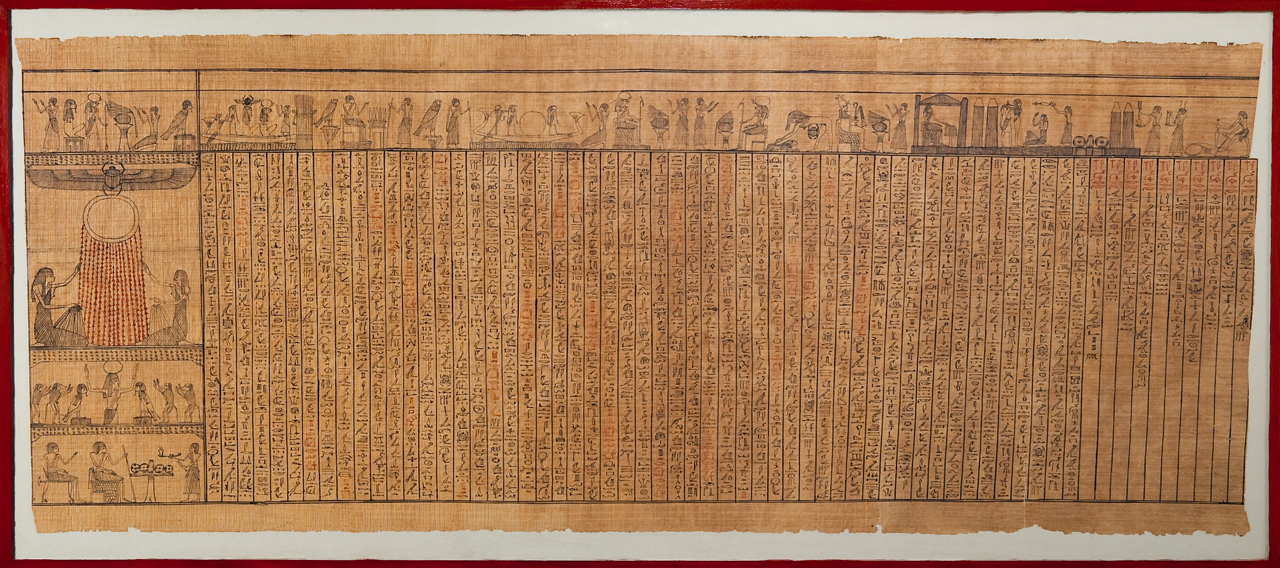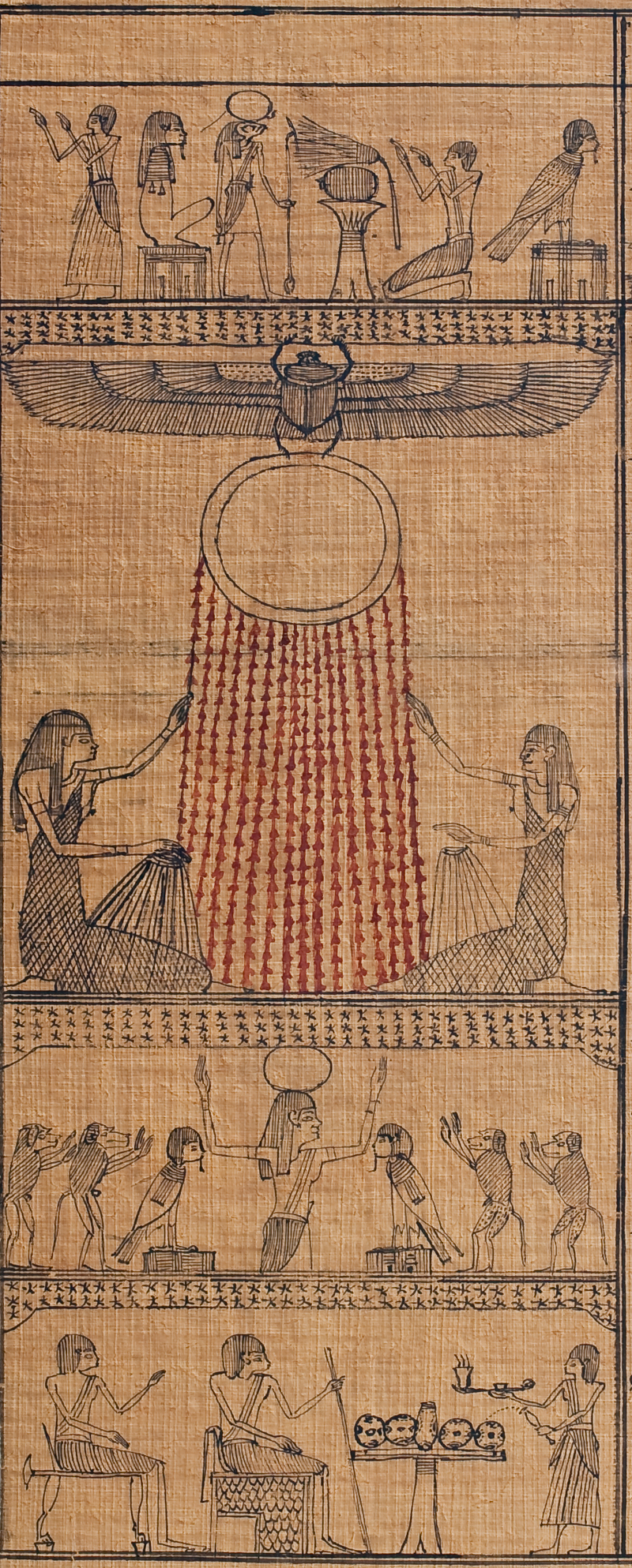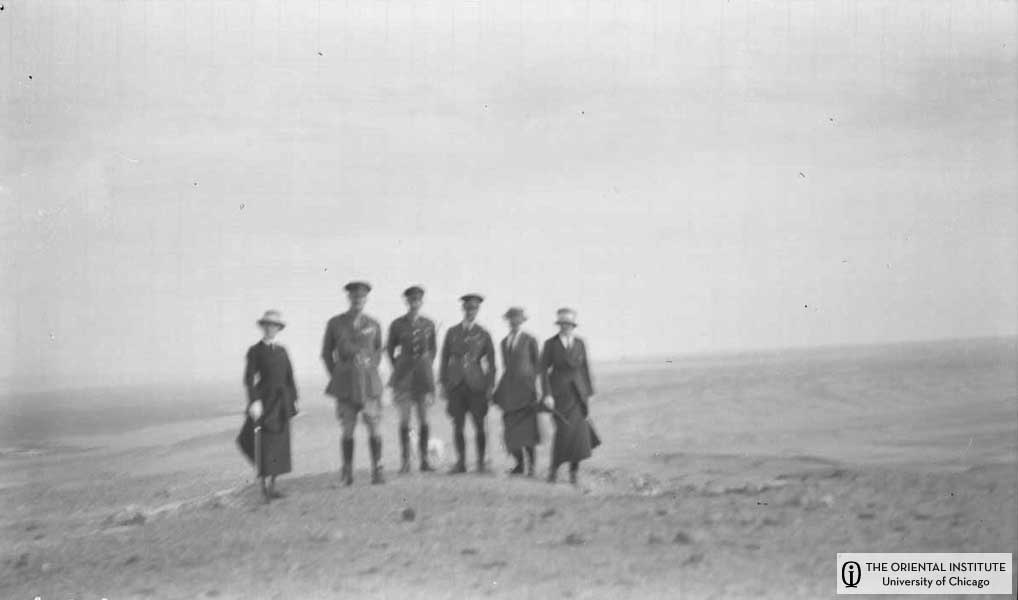Purchasing Antiquities in Cairo
December 25, 1919
As I’ve said, most of my time is spent touring the various antiquities dealers, haggling constantly in hopes that I can get better prices, or that they will come to show me the best artifacts that they have hidden away for the most serious buyers. I recently came upon the most beautiful papyrus of the Book of the Dead, which I absolutely had to have. I have copied here part a letter I sent to Mrs. Anderson who provided the funds for just such a special purchase:
Villa Mandofia, Cairo, Egypt; December 10, 1919
My dear Mrs. Anderson-
…In this way I have spent many days among the dealers endeavoring to find some fairly defined group of things to which I could devote your gift, and which at the same time might be divisible between New York and Chicago, in accordance with your wish. Meantime all the other funds I had with me for purchasing were spent.
One day I was in the shop of a particularly hard-headed Greek with an Italian name, Tano, of whom I had bought a good many things, some of them at quite reasonable prices. He asked me if I was interested in Babylonian things, and brought out a box containing 258 clay tablet letters and contracts written in Babylonian cuneiform or wedge writing. They had been brought into Egypt by a Syrian merchant from Aleppo. Professor Sayce of Oxford had advised the University of Dublin to buy them for fifty pounds, but as that was long ago (he showed me Sayce’s letter), and the university had sent no money, I could have them if I wanted them. Well I took them, and that about exhausted my funds, and your gift was still unexpended. What did then this canny oriental do but told me he had a papyrus which was very fine! There had been references to this papyrus before by his clerk, but I had discounted the glowing accounts of it. One hears such tales constantly out here, and all prove to be cock-and-bull stories. This papyrus, said Tano, was over at the rug dealer’s where the statues were stowed away under the counter! So I went over with Tano, for the place was just across the street, and after some parlaying, he secured possession of a mysterious box which we brought back to his own shop. I though of the ragged and tattered masses of papyrus which I had handled at Nahman’s - the kind of thing we always think of when we hear of papyri just out of the ground. For in almost all cases they survive as worm-eaten fragments, rarely showing any resemblance to a roll. If a roll does survive, the natives who find it usually break the roll straight across as one would break a stick, in order to divide the plunder. So after Tano had carefully locked his shop door, I was only moderately interested as he began to open his box. When the lid came off, I saw a lot of mummy cloth bandages lying under it and said to myself, “Of course it is the usual mess of tatters.” And then I could hardly believe my eyes, for I saw something which I have never yet seen in all my years in Egypt. Tano lifted the mummy wrappings, and lying under them was a beautiful brown roll of papyrus, as fresh and uninjured as if it had been a roll of wall paper just arrived from the shop! And it was about as thick as an ordinary roll of wall paper!
I confess I had some difficulty in maintaining a “poker face.” When Tano seized it and lifted it out, my heart came into my throat lest he should break away the outer portions, for in this dry climate papyrus is very brittle. But it would not do to betray the slightest concern. Tano laid it down on the table, put his finger on the unrolled inch or two and giving the roll a fillip, he sent it gliding across the table, exposing a perfectly intact bare surface before the beginning of the writing. It was the first uninjured beginning of a papyrus I had ever seen unrolled and the first roll I ever saw in such perfect condition that it could be thus unrolled as its owner might have done. And then came the writing! An exquisitely written hieroglyphic copy of the Book of the Dead with wonderfully wrought vignettes, the finest copy of the Book of the Dead which has left Egypt for many years!
 Papyrus Milbank, currently on display at the Oriental Institute Museum (image courtesy of the Oriental Institute)
Papyrus Milbank, currently on display at the Oriental Institute Museum (image courtesy of the Oriental Institute)
Tano now wanted to stop and go no further, lest he should injure the roll. I said: ”If you want to do business with me, I must see it to the end.” So I rolled up as he unrolled, for we had to dispose of it as it was unrolled. A beautifully changing panorama of vignettes, done with exquisite refinement in detail rolled on before my eyes, and among others I saw a chapter with a remark of the scribe at the end, that it had been found in the days of Menkure, the great Pharaoh who built the third pyramid of Gizeh, nearly 2000 years before this papyrus was written.
Great beads of perspiration stood out on Tano’s forehead. It was a long and painfully delicate task, for the roll was probably over forty feet long. But at last I had seen it, and it was rolled back without mishap. At this juncture I claim a long credit mark. I knew I was in no state of mind to jockey with this canny oriental. So I told him I was tired, and went home without saying a word about buying the papyrus.
I waited two days, doing much thinking - chiefly what a beautiful publication this new papyrus, the “Papyrus Anderson” was going to make, and how pleased Mrs. Anderson would be to see it! But there were formidable obstacles in the way. Would I be able to maneuver this cursed oriental money-bags to a point where he would take 500 pounds for the papyrus? Lord Carnarvon’s agent was due to arrive in a few days, and probably old Tano knew it. And after him there was Budge of the British Museum, and both of these men would want it and would outbid me if they could. So I was bound to move at once. I would tire you if I were to attempt to tell you of the jockeying which followed, how often I went into Tano’s shop and talked of everything in the place except papyri! The provoking old reprobate was of course quite willing to talk for hours of anything else but papyri! However, Lord Carnarvon’s agent passed up the river several days ago, and I have the beautiful papyrus safely packed in cotton in a tin tube in my trunk, Tano has 500 pounds, and both of us are happy!
Of course a papyrus as fine as this must be published in facsimile for the use of scholars and libraries all over the world. It will make a beautiful volume of fifty or sixty fine facsimile photo-engraved plates, preceded by an introductory explanatory text analyzing the document and giving something of its history. It was found at Assiut in a tomb excavated by a rich native named Said Bey Khaehaba, who says that the coffin in which it lay belonged to a physician, and that this coffin is now in the national museum here. I have not yet had time to run down this clue, but all this and a sketch of the content of the document will have to be worked up and included in the printed introduction. The whole will be preceded by a title page headed
PAPYRUS ANDERSON.
Or if you prefer it we can call it “Papyrus Milbank.” [Mrs. Anderson’s last name was Milbank, and she ultimately chose to name it Papyrus Milbank] It will then become current as one of the standard texts of the Book of the Dead.
All this, as I said above, had been going through my mind before I had completed the purchase of the papyrus, and I did not realize until I had the document safely rescued from competing buyers, that I was involved in a further difficulty. According to the terms of your gift the purchases made with it are to be divided between Chicago and New York; and of course a superb manuscript cannot be cut in two. There is no way to divide papyrus Anderson between New York and Chicago. I would like to ask you therefore whether you approve of the following suggestions:
That the present investment of your gift in Papyrus Anderson continue until next season with the purpose of giving me time to secure other funds with which to pay for the papyrus. Then having the funds representing your gift again in my hands in cash form, I can take the time to find another purchase such that it can be properly divided between New York and Chicago, in accordance with your wishes. But of course the manuscript remains the Papyrus Anderson - and quite appropriately too for it was your gift which enabled me to save this beautiful book, which had been lying in an Egyptian tomb since before Homer’s time, from being carried away to some European museum or private collection; and whatever decision you make it was your gift which brought this superb copy of the Book of the Dead to America.
 Close-up of Papyrus Milbank, on display at the Oriental Institute Museum (image courtesy of the Oriental Institute)
Close-up of Papyrus Milbank, on display at the Oriental Institute Museum (image courtesy of the Oriental Institute)
December 24, 1919 - I have spent much more of my funds than I had anticipated, but I can’t let these unprecedented opportunities for such magnificent artifacts slip through our fingers! I sent President Judson of the University of Chicago a request for 5,000 more dollars, for there are more artifacts I simply cannot in good faith let get away, and I received the most wonderful Christmas present in return. A cable came from him yesterday and reads: “Luckenbill brings you twenty-give thousand more for purchases. Judson.” I cannot imagine what has happened but I am ever so pleased, we shall have the most magnificent museum collection of Egyptian antiquities in the America at this rate!
Here is an updated itinerary of where we expect to be in the coming months so that you don’t worry, though it will likely change based on how disordered everything is here, but I have hopes to be back in Chicago by September:
- Sail from Port Said about February 10.
- Reach Bosra about March first.
- Leave Bosra about March fifth
- Leave Baghdad about April first
- Leave Mosul about May first
- Leave Aleppo about June first
- Leave Beirut about July first
- Leave Jerusalem about August first
- Leave Crete about August fifteenth
- Leave England about August 25th for New York.
 Abu Roash: Lord and Lady Allenby on ramp to pyramid; December 15, 1919 (N. 4196)
Abu Roash: Lord and Lady Allenby on ramp to pyramid; December 15, 1919 (N. 4196)
For the full story of my exciting trip come to the special exhibit “Pioneers to the Past: American Archaeologists in the Middle East, 1919-1920,” at the Oriental Institute!
1155 East 58th Street Chicago, IL 60637
Hours:
- Tuesday 10:00 am to 6:00 pm
- Wednesday 10:00 am to 8:30 pm
- Thursday 10:00 am to 6:00 pm
- Friday 10:00 am to 6:00 pm
- Saturday 10:00 am to 6:00 pm
- Sunday noon to 6:00 pm
- Closed Mondays
http://oi.uchicago.edu/museum/special/pioneer/
And visit me on facebook at: http://www.facebook.com/profile.php?id=3318774#/profile.php?v=info&ref=profile&id=100000555713577